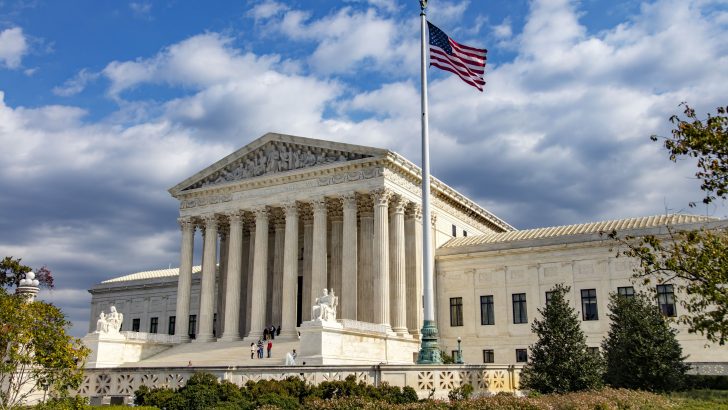American liberals are horrified at the thought of a Supreme Court judge imposing their view on the law, writes David Quinn
The US Supreme Court is an extremely powerful body. Unlike in Ireland, it is very difficult to pass a constitutional referendum in the United States, and therefore when the Supreme Court passes a judgement, that is often the end of the matter.
A classic example is Roe vs Wade, the famous, or rather infamous, decision of 1973 that legalised abortion on extremely broad grounds right across all of America’s 50 states.
Prior to Roe vs Wade, it was up to each individual state to decide its own abortion law. After Roe vs Wade, every state was left with no choice but to introduce abortion on very liberal grounds. If Roe vs Wade was ever overturned abortion would not be prohibited, it would simply go back to the states, and some states would have more liberal laws than others and voters would have much more power over the matter.
Ever since Roe vs Wade battles between Democrats (now dogmatically pro-choice) and Republicans (generally pro-life) over who gets to be on the Supreme Court have grown ever more intense.
Nine judges are meant to serve on the Supreme Court at any one time, meaning you need to get five on your side in a particular case to win the day. For years, there has been a liberal majority on the court, even though Republicans have controlled the White House and the Senate for much of the time since Roe v Wade.
Vacancy
A position becomes vacant on the bench when a judge either dies or retires. The recent death of Ruth Bader Ginsburg has created a new vacancy. She was firmly on the pro-choice side and a hero to feminists as a result.
Prior to her death, there was a 5-4 conservative majority on the Supreme Court, although the Chief Justice, Jason Roberts, appointed under George W. Bush, is more of a centrist.
But the death of Ms Ginsberg gives Donald Trump and the Republican-controlled Senate a golden opportunity to shift the court more in a pro-life direction and they are seizing the chance with both hands, just as the Democrats undoubtedly would in the same situation.
President Trump has nominated Amy Coney Barrett, a law professor from Notre Dame University in South Bend, Indiana, who currently serves on the Court of Appeals for the Seventh Circuit.
Ms Barrett is a devout Catholic and fully pro-life. If she is confirmed in the next few weeks, ahead of the American elections, the ostensible conservative majority on the Supreme Court will shift from 5-4 to 6-3.
This is what the pro-abortion movement in America dreads. What might then happen is that a case works its way to the Supreme Court which gives the court a chance to either overturn it, or (more likely) amend it in such a way as to make it less far-reaching and hand some power back to states.
As we know from bitter experience here, being Catholic on paper is no guarantee that you will be Catholic in practice”
It’s a striking thing that out of the eight judges currently on the court, two are Jewish (Ms Ginsburg was also Jewish), one grew up Catholic and then converted to Episcopalianism (the US version of the Church of Ireland), but the other five are Catholic. Maybe it’s because Judaism is a very law-based religion, and Catholic moral theology is heavily grounded in the natural law.
If Ms Barrett is confirmed, then six of the nine judges will be Catholics, a remarkable situation given that Catholic make up about a fifth of the US population but would make up two-thirds of the court.
It is also remarkable that three of the nine before the death of Ruth Bader Ginsburg were Jewish, given that Jewish people make up only 2% of Americans.
It is a testament to the influence of Catholics and Jews in the American legal system.
Mind you, the religion of a judge does not necessarily act as a predictor of how they will vote in any given case. For example, Sonia Sotomayor is Catholic but was appointed under the very pro-choice Barack Obama and is herself pro-choice.
As we know from bitter experience here, being Catholic on paper is no guarantee that you will be Catholic in practice.
This, of course, is what liberals fear about Amy Coney Barrett; she is much more than nominally Catholic and they think she will bring her Catholic beliefs, including her pro-life ones, to bear on her legal decisions.
Pro-choice stalwart
When Ms Barrett was nominated to the Court of Appeals in 2017, Democrat and pro-choice stalwart, Senator Dianne Feinstein said to her, “the dogma lives loudly within you, and that is a concern”.
This was despite what Ms Barrett had just told Sen. Feinstein. Ms Barrett was addressing whether her Catholic beliefs would bear on her interpretation of the law and she said: “My personal Church affiliation or my religious belief would not bear on the discharge of my duties as a judge”.” She added: “It is never appropriate for a judge to impose that judge’s personal convictions, whether they arise from faith or anywhere else, on the law.”
In other words, it is Ms Barrett’s philosophy to interpret the law as it is written and not impose any personal beliefs on it, religious or otherwise.
‘Neutral’
The irony is that the judges who voted for abortion in Roe vs Wade did just that. They found a ‘right’ to abortion that is not in the US Constitution at all. Did the ‘dogma’ live loudly in them? Does it live loudly in all judges who are staunchly in favour of abortion? Why are they considered neutral in their approach to law and Ms Barrett is not?
What is really going on here is that pro-choice campaigners dread judges doing what they do, namely impose their views on the law rather than simply interpret it as it written, which is what Amy Coney Barrett aims to do.
She would be an adornment to the Supreme Court.


 David Quinn
David Quinn
